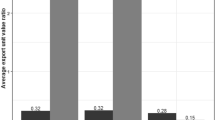Abstract.
In this paper we assess the effectiveness of the Market Promotion Program (MPP) in increasing U.S. exports and benefitting U.S. agricultural producers and food processors. Export shipments are linked to producer welfare using Kohli's (1978) profit maximization (GNP function) approach to modeling international trade. Using estimated profit functions in conjunction with a synthetic export demand function for processed agricultural products, we compute changes in farm and food processing sector profits that result from alternative own-price and advertising elasticities of export demand with and without the MPP subsidy. This approach allows us to investigate aggregate welfare effects of nonprice promotion without requiring the difficult task of estimating the export demand effects of market promotion activities for numerous commodities and importing countries.
Similar content being viewed by others
Author information
Authors and Affiliations
Additional information
First version received: April 1999/Final version received: June 2000
Rights and permissions
About this article
Cite this article
Love, H., Porras, J. & Shumway, C. Measuring the effectiveness of non-price export promotion using a supply-side approach. Empirical Economics 26, 367–389 (2001). https://doi.org/10.1007/s001810000045
Issue Date:
DOI: https://doi.org/10.1007/s001810000045




